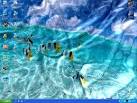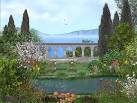Animated Nature Wallpapers For Desktop Biography
Wallpaper, using the printmaking technique of woodcut, gained popularity in Renaissance Europe amongst the emerging gentry. The elite of society were accustomed to hanging large tapestries on the walls of their homes, a tradition from the Middle Ages. These tapestries added color to the room as well as providing an insulating layer between the stone walls and the room, thus retaining heat in the room. However, tapestries were extremely expensive and so only the very rich could afford them. Less well-off members of the elite, unable to buy tapestries due either to prices or wars preventing international trade, turned to wallpaper to brighten up their rooms. Early wallpaper featured scenes similar to those depicted on tapestries, and large sheets of the paper were sometimes hung loose on the walls, in the style of tapestries, and sometimes pasted as today. Prints were very often pasted to walls, instead of being framed and hung, and the largest sizes of prints, which came in several sheets, were probably mainly intended to be pasted to walls. Some important artists made such pieces, notably Albrecht Dürer, who worked on both large picture prints and also ornament prints intended for wall-hanging. The largest picture print was The Triumphal Arch commissioned by the Holy Roman Emperor Maximilian I and completed in 1515. This measured a colossal 3.57 by 2.95 metres, made up of 192 sheets, and was printed in a first edition of 700 copies, intended to be hung in palaces and, in particular, town halls, after hand-coloring. Very few samples of the earliest repeating pattern wallpapers survive, but there are a large number of old master prints, often in engraving of repeating or repeatable decorative patterns. These are called ornament prints and were intended as models for wallpaper makers, among other uses. England and France were leaders in European wallpaper manufacturing. Among the earliest known samples is one found on a wall from England and is printed on the back of a London proclamation of 1509. It became very popular in England following Henry VIII's excommunication from the Catholic Church - English aristocrats had always imported tapestries from Flanders and Arras, but Henry VIII's split with the Catholic Church had resulted in a fall in trade with Europe. Without any tapestry manufacturers in England, English gentry and aristocracy alike turned to wallpaper During the Protectorate under Oliver Cromwell, the manufacture of wallpaper, seen as a frivolous item by the Puritan government, was halted. Following the Restoration of Charles II, wealthy people across England began demanding wallpaper again - Cromwell's regime had imposed a boring culture on people, and following his death, wealthy people began purchasing comfortable domestic items which had been banned under the Puritan state. In 1712, during the reign of Queen Anne, a wallpaper tax was introduced which was not abolished until 1836. By the mid-eighteenth century, Britain was the leading wallpaper manufacturer in Europe, exporting vast quantities to Europe in addition to selling on the middle-class British market. However this trade was seriously disrupted in 1755 by the Seven Years War and later the Napoleonic Wars, and by a heavy level of duty on imports to France








Wallpaper, using the printmaking technique of woodcut, gained popularity in Renaissance Europe amongst the emerging gentry. The elite of society were accustomed to hanging large tapestries on the walls of their homes, a tradition from the Middle Ages. These tapestries added color to the room as well as providing an insulating layer between the stone walls and the room, thus retaining heat in the room. However, tapestries were extremely expensive and so only the very rich could afford them. Less well-off members of the elite, unable to buy tapestries due either to prices or wars preventing international trade, turned to wallpaper to brighten up their rooms. Early wallpaper featured scenes similar to those depicted on tapestries, and large sheets of the paper were sometimes hung loose on the walls, in the style of tapestries, and sometimes pasted as today. Prints were very often pasted to walls, instead of being framed and hung, and the largest sizes of prints, which came in several sheets, were probably mainly intended to be pasted to walls. Some important artists made such pieces, notably Albrecht Dürer, who worked on both large picture prints and also ornament prints intended for wall-hanging. The largest picture print was The Triumphal Arch commissioned by the Holy Roman Emperor Maximilian I and completed in 1515. This measured a colossal 3.57 by 2.95 metres, made up of 192 sheets, and was printed in a first edition of 700 copies, intended to be hung in palaces and, in particular, town halls, after hand-coloring. Very few samples of the earliest repeating pattern wallpapers survive, but there are a large number of old master prints, often in engraving of repeating or repeatable decorative patterns. These are called ornament prints and were intended as models for wallpaper makers, among other uses. England and France were leaders in European wallpaper manufacturing. Among the earliest known samples is one found on a wall from England and is printed on the back of a London proclamation of 1509. It became very popular in England following Henry VIII's excommunication from the Catholic Church - English aristocrats had always imported tapestries from Flanders and Arras, but Henry VIII's split with the Catholic Church had resulted in a fall in trade with Europe. Without any tapestry manufacturers in England, English gentry and aristocracy alike turned to wallpaper During the Protectorate under Oliver Cromwell, the manufacture of wallpaper, seen as a frivolous item by the Puritan government, was halted. Following the Restoration of Charles II, wealthy people across England began demanding wallpaper again - Cromwell's regime had imposed a boring culture on people, and following his death, wealthy people began purchasing comfortable domestic items which had been banned under the Puritan state. In 1712, during the reign of Queen Anne, a wallpaper tax was introduced which was not abolished until 1836. By the mid-eighteenth century, Britain was the leading wallpaper manufacturer in Europe, exporting vast quantities to Europe in addition to selling on the middle-class British market. However this trade was seriously disrupted in 1755 by the Seven Years War and later the Napoleonic Wars, and by a heavy level of duty on imports to France
Animated Nature Wallpapers For Desktop
Animated Nature Wallpapers For Desktop
Animated Nature Wallpapers For Desktop
Animated Nature Wallpapers For Desktop
Animated Nature Wallpapers For Desktop
Animated Nature Wallpapers For Desktop
Animated Nature Wallpapers For Desktop
Animated Nature Wallpapers For Desktop
Animated Nature Wallpapers For Desktop
Dream Scene - Animated wallpapers Desktop Background, Read Description.
Animated Wallpaper And Desktop Backgrounds Ocean Rock.Mpg
No comments:
Post a Comment